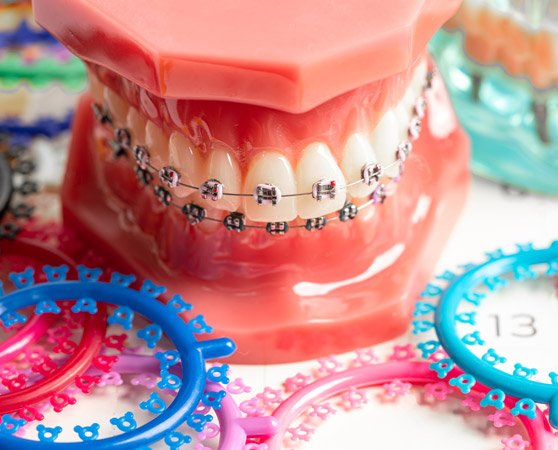Braces & Aligners
Home / Braces & Aligners
Orthodontic treatments, such as braces and aligners, are designed to correct dental malalignments and improve overall oral health. These treatments address issues like overcrowding, spaces, openbite, deepbite, crossbites, shifted midline,contributing to both the aesthetic appearance and functionality of the teeth.
Phone
+91 9833512034
dentarc1@gmail.com
Request a Consult
Braces
Traditional braces consist of metal brackets that are bonded to each tooth and connected by archwires. These braces apply continuous pressure to gradually move teeth into their proper positions. Over time, advancements in orthodontics have introduced various options to make braces more comfortable and aesthetically pleasing:

1. Ceramic Braces
Ceramic braces use brackets made of tooth-colored or clear materials, making them less noticeable than traditional metal braces. They are a popular choice for patients seeking a more discreet option.
2. Lingual Braces
Lingual braces are similar to traditional braces but are placed on the inner surfaces of the teeth, making them invisible from the outside. This option is ideal for patients who want the benefits of braces without the visible metal brackets.
3. Self-Ligating Braces
Self-ligating braces use a special clip instead of elastic bands to hold the archwire in place. This design reduces friction and allows for easier adjustments, potentially shortening treatment time.
1. Ceramic Braces
Ceramic braces use brackets made of tooth-colored or clear materials, making them less noticeable than traditional metal braces. They are a popular choice for patients seeking a more discreet option.
2. Lingual Braces
Lingual braces are similar to traditional braces but are placed on the inner surfaces of the teeth, making them invisible from the outside. This option is ideal for patients who want the benefits of braces without the visible metal brackets.
3. Self-Ligating Braces
Self-ligating braces use a special clip instead of elastic bands to hold the archwire in place. This design reduces friction and allows for easier adjustments, potentially shortening treatment time.
Clear Aligners
Clear aligners, such as Invisalign, offer a removable and nearly invisible alternative to traditional braces. These custom-made, transparent plastic trays fit snugly over the teeth and are replaced every one to two weeks to gradually shift the teeth into their desired positions.

Treatment Process
1. Initial Consultation
The orthodontist conducts a comprehensive examination, including X-rays, photographs, and digital scans, to assess the patient's dental condition and create a detailed treatment plan.
2. Fitting Braces or Aligners
For braces, the orthodontist bonds the brackets to the teeth and connects them with archwires, making periodic adjustments as needed.
For aligners, the patient receives a series of custom trays that are worn according to the treatment plan, typically for 20-22 hours a day.
3. Follow-Up Visits
Regular follow-up appointments are essential to monitor progress, make necessary adjustments, and ensure optimal results.
Benefits of Braces & Aligners
Improved Aesthetics
Aligned teeth contribute to a more attractive smile and boost self-confidence.
Enhanced Functionality
Correcting bite issues improves chewing, speaking, and overall oral function.

Better Oral Health
Properly aligned teeth are easier to clean, reducing the risk of cavities, gum disease, and other dental problems.
Considerations
Duration
Orthodontic treatment typically lasts between one to three years, depending on the complexity of the case. The duration may vary for each patient and can be influenced by factors such as the severity of the misalignment and the type of treatment used.
Cost
The cost of braces and aligners varies based on the type of treatment and individual needs. Discussing payment options and insurance coverage with the orthodontist is essential.
Compliance
For aligners, patient compliance is crucial for effective results, requiring diligent use as prescribed. Failure to wear the aligners for the recommended amount of time can prolong the treatment duration and affect the overall outcome.
